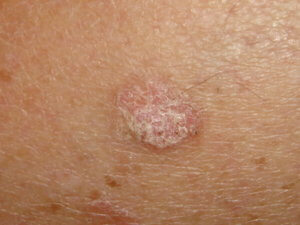Actinic Keratosis (AK) or Sunspot
Description
Actinic Keratosis are lesions that arise from the cells that form the main structural part of the outer layer of skin, the epidermis. The main cause is thought to be chronic UV exposure, usually from the sun, and possibly from solariums. They are more common the closer you live to the equator. A high percentage of fair skinned people in Australia will get at least one AK during their lifetime, and unfortunately some people get hundreds of these lesions. AK is considered a type of pre-cancerous lesion, rather than a true skin cancer, however they can undergo growth and transform into a squamous cell skin cancer (SCC). Fortunately only a few percent of AK's ever transform into an SCC, whereas an SCC is most likely to have arisen from an AK!
Who is at risk?
People with fair skin, particularly those that get sunburnt easily and spend a lot of time outdoors without sun protection are particularly prone to this type of skin lesion. They occur less commonly in people with olive and darker complexions. Because UV damage to the skin is cumulative, outdoor workers and those who spend a lot of leisure time outdoors are at high risk of AK - which is why it is necessary to always remember to wear sun protective clothing and protect the skin from the sun when outdoors. People who develop a lot of actinic keratoses and have a lot of sun damaged skin are prone to the development of SCC. Whilst AK can arise in people under the age of 40, it is much more common over that age. People who are immunosuppressed, such as those who take anti-rejection medications following an organ transplant, are particularly prone to AK's and other skin cancers.
Detection
AK most commonly arises on sun exposed sites, particularly the bald scalp, forehead, temples, ears, nose, lower lips and the back of hands. They are generally slightly rough scaling skin spots a few millimetres in size and may be a little tender if rubbed, or tender in sunlight. A small skin biopsy may be required to confirm the diagnosis. If an AK is detected then a suitable management plan can be tailored according to the location and subtype.
Treatment
The vast majority of AK’s are able to be completely cured by your doctor, usually with methods such as freezing and topical creams, or with surgical methods. Occasionally they disappear without any treatment, this is most likely if adequate sun protection measures are followed.
Recurrence
Sometimes after treatment of an AK, the lesion recurs. If a lesion recurs a short time following treatment then the lesion should be reassessed by your doctor to consider the possibility that it may have become an SCC.
People who have had a previous AK are at increased risk of getting new AK’s. For this reason, a regular complete skin examination by your doctor is advisable, as well as regular self skin examination. In addition, strict adherence to adequate sun protection measures should be adopted.


